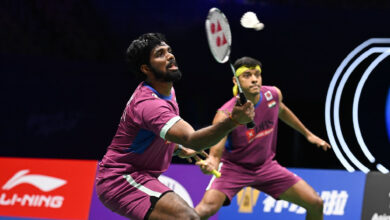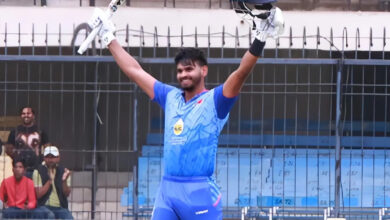Border-Gavaskar Trophy: Australia still undecided about Lyon’s spin partner(s) for helpful Nagpur pitch

Like a doctor feeling the pulse of a patient, Nathan Lyon knelt down and moved his hand through the light-brown barren surface at the Jamtha Stadium. He would adjust his perch, probing for clues, roving for signs, and gently thud different parts of the surface to feel its firmness and dryness. After the 15-minute interaction with the pitch, he walked to the adjacent surface where his spin bowling colleagues were restlessly waiting for his diagnosis, like relatives of a patient waiting for a doctor’s diagnosis. The quartet was engaged in a brief chat, though all one could spot was Lyon talking and the others lening to him and nodding their heads like obedient students.
The veteran off-spinner would then take them to the brownest pitch on the square, which wore a bruised look after being used for three days of practice the Indian team. He picked and marked some spots for them to hit the ball, and would observe them, like a bowling coach would. Left-arm spinner Ashton Agar erred on the fuller side and Lyon gestured at him to shorten his length a wee bit and prompted him to re-measure his run-up. Leg-spinner Mitchell Swepson found delightful drift and ripping turn that earned claps from Lyon and some others who had scattered around them.
Then trotted in Todd Murphy, yet to make his Test debut, just half a dozen first-class games old, but touted the heir apparent to Lyon, who turned 35 in November. But it’s not Lyon that Murphy’s action reminds one of, but Graeme Swann, albeit a slightly quicker-through-his-action Swann. The front-on run-up, the load-up, the ball clasped near the chest, the fluid release, the follow-through and the clap-celebration, all have the stamp of Swann.
An early look at the Nagpur pitch 👀 #INDvAUS pic.twitter.com/S3BIu7qti8
— cricket.com.au (@cricketcomau) February 7, 2023
The latter himself was stunned to stumble on his clone. “Er… wow, this is awkward,” he tweeted under a video of Murphy castling West Indies batsman Joshua Da Silva through the gate during a warm-up game, foxing him with flight and inward drift.
But it’s to his compatriot that Murphy looks up to. He would cling to Lyon like a shadow. He has never bowled in tandem with Lyon. When Lyon bowls, he would observe everything – from his run-up to what he does with the ball. When Lyon had Peter Handscomb edging, Murphy even roared a “wow.” After every ball he bowled, he would seek Lyon’s feedback with imploring eyes. He would suggest this or that, and Murphy would len with still eyes. There was a classical mentor-ward vibe about them. There were instances when Marnus Labuschagne drove him airily, and Lyon would encourage him to still keep flighting the ball.
Like both Swann and Lyon, there is no mystery to Murphy, no doosra or carrom ball. He is an orthodox finger-spinner, not experimental like Ravichandran Ashwin, or a freak of nature like Muttiah Muralitharan. And some of his teammates and coaches could spot the blossoming of a genuine wicket-taker.
His childhood coach Chris Howard told Cricket Australia: “The most difficult conditions (for spinners) are Australian conditions; non-abrasive conditions are the most challenging because you’ve really got to beat people in the air. And he certainly can do that, so adapting to highly abrasive conditions is a lot easier than trying to do it the other way.”
Not a prodigious turner of the ball, Murphy gets the ball to drop alarmingly at batsmen. “He spins up at the back of the ball, which means he’s going to get a lot of drop. He’s going to get a lot of bounce and in the right condition, spin,” Steve O’Keefe, the hangman in Australia’s last Test victory in India, observed to The Sydney Morning Herald.
Break from the past
Should the youngster make his Test debut, it would be the first time in 35 years that Australia would field a pair of off-spinners in a Test. But it is not as straightforward as Australia possess two other spinners who have already experienced Test cricket, though not with great returns. One of them is Agar, a left-arm spinner, the tribe that has been successful against India in recent times. But he is now more of a white-ball exponent, and has played just a handful of first-class games over the last three years, and was picked from first-class obscurity for a Test against South Africa in January.
In the rain-curbed fixture, he went wicketless in 22 overs on a dry Sydney surface forked to simulate sub-continental conditions. Agar barely purchased snap or bite when he bowled on a crack-laden surface near the centre wicket in Jamtha, though he bowled tight stump-to-stump lines. Had India’s been a left-handed-heavy order, his prospects would have been brighter, as according to Steve Smith a crack outside the left-hander’s off-stump is already a bit loose, though it’s on the fuller side to cause a real threat. That the last first-class game at the venue saw left-arm spinners grab nine last-innings scalps could nudge his case too.
Nonetheless, Agar toiled endlessly in the nets, watched on observantly head coach Andrew McDonald, before he put on the pads and freewheeled.
Leg-spinner Swepson is more of a throwback, slower through the air and relying almost exclusively on old-fashioned virtues like drift and turn. Unlike most white-ball-fixated leggies, he bowls leg-breaks (more of slow turn than frightening fizz) more than wrong’uns, though he does possess a sharp one, from a slightly low release point.
While who would likely partner Lyon has been subject to many debates and much conjecture, Smith even suggested the possibility of Australia loading three spinners, a horical exception, in the press conference.
As Australia wrapped up their practice, Lyon and friends wanted to take one final peep at the deck, now under a cream tarpaulin sheet. They couldn’t, but the pulse and vibes Lyon senses from the pitch on Wednesday could decide the identity of his accomplice(s) too.







